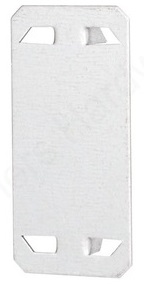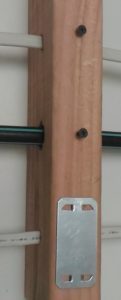Overview

A Cable Protector Plate (also called Nail Stops or Safe Plates) is a steel plate with teeth that is hammered onto the surface of studs or nogs to prevent damage from nails or screws to underlying pipes or wires. These are required in many countries as part of that country’s electrical code1, and also protect gas and plumbing lines.

In New Zealand, electrical code allows for Cable Protector Plates as a physical means to prevent penetration to to electrical cables within 50 mm of the stud surface2. The code also allows alternatives to minimize consequences if physical prevention is not used. Alternatives include using grounded metal cladding or conduit, or the use of an RCD (Residual Current Device) at the circuit panel. Either of these alternatives is intended to shut off the circuit at the breaker panel until the fault is repaired. However, the line will still need to be repaired because the damage was not prevented. The use of Cable Protector Plates are intended to prevent the damage, so a nail or screw will hit the Plate and stop, never damaging the wires beneath it.
An additional NZ electrical code requires the use of an RCD to protect every circuit that has outlets or lights. However, this requirement excludes appliances that are hardwired like water heaters, hobs, ovens, stoves, and sometimes heat pumps. Any circuits not protected by an RCD will still require alternative protection, and Cable Protection Plates are a very economical solution. However, these hardwired lines are often not protected by an RCD and are sometimes left completely unprotected, which violate code (ANZ 3000 Section 3.9.4.3.2 and 3.9.4.4).
In New Zealand, Cable Protection Plates are included in the building code to prevent damage to electrical lines. To date, New Zealand has also overlooked protecting water and gas plumbing from puncture damage. However, this disregard doesn't prevent damage, and 'call backs' to repair punctured lines are required. The possible repercussions of these punctures can be very costly and dangerous. Punctured gas lines can result in explosions and fire, and punctured water lines can result in slow leaks that can cause delayed and significant water damage. These could have been easily prevented by using an inexpensive and easy to install Cable Protector Plate
1 US Building Code Article 300.4; Canadian CEC Rule 12-516; English NHBC Standards Chapter 8.1, European IK Code BS EN 62262:2002
2 ANZ 3000 Section 3.9.4.3.2, and 3.9.4.4
What do we recommend?
Gas Lines
At a minimum, we recommend that any gas lines within walls be protected by Cable Protector Plates. The cost of the plates is just too low not to use especially when the possible outcome of an accidental puncture of a gas line is so catastrophic.
Water Lines
The use of Cable Protector Plates on water lines is recommended when water lines are run near the surface of the stud, or have a higher chance of puncture like with longer cabinet screws in bathrooms or kitchens. Some plumbers prefer to use channels into the surface of the stud to run water lines instead of drilling holes near the middle. This places water lines well with the reach of all drywall screws, trim nails, and any screws or nails that a homeowner will use to hang anything on a wall. We have also heard experiences from builders where a nail plugs a puncture and it takes months for the nail to rust and cause a visible leak. That plumbing passed initial pressure tests, but still resulted in a leak months later.
Electrical Lines
We also recommend at a minimum following NZ building code and use a Cable Protector Plate on any electrical line which isn’t housed in grounded metal cladding or protected by an RCD, and within 50 mm of the surface of the stud. Again, these would include cables for water heaters, hobs, stoves, ovens, and sometimes heat transfer pumps (if not protected by an RCD). It may also be useful to use Cable Protector plates in areas where cables run close to the stud surface or where longer screws are expected including bathrooms and kitchens for cabinets or where TVs, electronics, shelves, or heavy/expensive artwork may be installed.
Ready to find out more?
Contact us today for more information, availability, or pricing!
